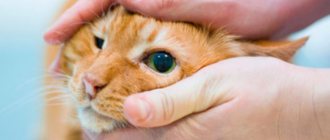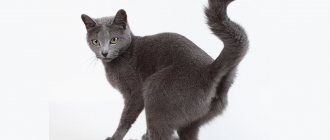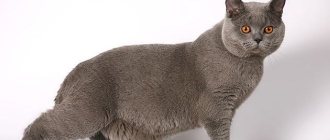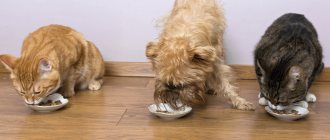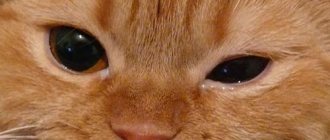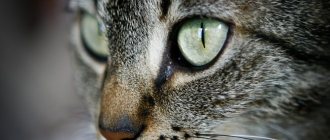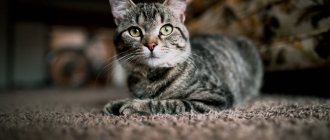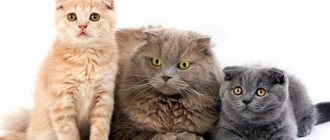Owners of Scottish cats often notice lacrimation in the animal.
Often the owner decides that this is a disease and begins to treat the pet. Before you take any action, you need to determine why your Scottish Fold cat's eyes are watering.
This usually occurs as a result of physiological factors, but sometimes the development of a symptom can trigger a serious illness.
It is necessary to distinguish normal discharge from the eyes from pathological ones. At the same time, the general condition of the animal, the nature and intensity of lacrimation, and the presence of accompanying signs are assessed.
The eye discharge in a kitten is different from that of an adult animal.
The choice of methods to eliminate this problem depends on the cause that provoked the development of the problem. In case of a pathological process, the veterinarian prescribes eye treatment products, which can be purchased at a regular or veterinary pharmacy.
Manifestations of pathology
Before treatment, the animal’s condition should be assessed, so pay attention to the duration and nature of eye discharge, the presence or absence of other symptoms.
Signs may be as follows:
profuse lacrimation;- swelling around the eyes;
- brown, green and yellow discharge;
- impurities of pus in the discharge.
A Scot with pathology may constantly rub his eyes.
In some cases, symptoms include:
- hyperthermia;
- copious nasal discharge;
- drowsiness;
- changes in habitual behavior;
- apathy;
- pet anxiety;
- cough.
If symptoms appear that are not normal, you should consult your veterinarian.
Watery eyes as a sign of disease
Watery eyes can be a symptom of both an eye disease and a general illness.
Watery eyes as a symptom of eye pathology occurs when:
- injury to the eye and eyelids - there is a narrowing of the palpebral fissure of the injured eye, redness of its mucous membranes, the appearance of discharge of a different nature: from bloody-mucous in case of a fresh injury to purulent if the eye has been injured for a long time. A cat with an eye injury should be taken to a doctor to diagnose the type of injury and prescribe appropriate therapy;
- inflammatory diseases of the eye and its adnexa, can be unilateral or bilateral in nature: conjunctivitis - inflammation of the conjunctiva. Manifests itself in: redness and swelling of the conjunctiva;
- photophobia;
- the third eyelid may fall out;
- possible narrowing of the palpebral fissure;
- the presence of mucous or mucopurulent discharge.
- redness and swelling of the eyelids;
- redness and swelling of the eyelids;
- severe pain syndrome;
- the presence of swelling on top in the area of the outer corner of the eye, painful on palpation;
What symptoms require urgent contact with a veterinarian?
You should consult a doctor if:
- persistent lacrimation - more than a day;
- a sharp foreign object is visible in the eye;
- redness and swelling of the eyelids;
- purulent nature of the discharge;
- clouding of the cornea of the eye;
- change in the color of the iris;
- prolapse of the third eyelid, both on one side and on both sides;
- blepharospasm (spasm of the eye muscles with closure of the eye);
- increased body temperature;
- the appearance of nasal discharge;
- disturbance of general well-being.
Breed Features
Discharge in the form of tears is considered a feature of the breed.
The Scottish Fold cat has an unusual eye structure. The animal's skull is not the same shape as that of other breeds, as a result of which there is a narrowing of the tear ducts.
In a normal cat, the nasolacrimal ducts are wide, so secretions pass through them. In a Scotsman, due to the narrowing of the passages, tears flow out of the eyes. This is especially noticeable after the cat wakes up.
Why do Scottish Fold cats have watery eyes?
Breeders and cat lovers know that Scottish kittens and adult pets often have watery eyes. In childhood, this symptom is more pronounced than in adulthood. The anatomical structure of the head and eyes of these cats has special differences. The canal coming from the lacrimal gland is shortened, so tears do not linger in the ducts and quickly come out. The predisposition is explained by the flattened shape of the skull, which determines the non-standard structure of the ocular analyzer.
Scots' eyeballs are large, so they require regular washing with tear fluid. Otherwise, the cat is at risk of drying out the cornea. At the same time, cats that show suspicious signs must be examined, since eye diseases are no less common in them than in other breeds.
Main reasons
Experts identify many factors that cause lacrimation in a pet.
Most often, pathology occurs due to the following reasons:
entry of a foreign body into an organ;- helminthic infestations;
- structural features of the head;
- allergic reaction to certain products;
- improper care of your pet;
- infectious diseases;
- eye injury.
If these reasons provoke lacrimation in a cat, then drug treatment is used.
Physiological reasons
If a symptom has developed as a result of physiological factors, eye treatment does not need to be performed.
These reasons include:
breed characteristics;- discharge from the eyes after eating;
- after waking up.
Light from fluorescent lamps is also considered a physiological reason for the development of this phenomenon: bright lighting irritates the eyes, and discharge begins to flow from them.
Disease provocateurs
Watery eyes are often caused by various diseases. The following infections can provoke a pathological phenomenon:
- chlamydia;
- herpes;
- rhinotracheitis of viral etiology.
Your cat may have other problems caused by pathogens.
Their symptom may also be bleeding from the eyes. A pathological phenomenon sometimes indicates conjunctivitis, the causative agents of which are viruses or bacteria .
Tears may be a sign of respiratory disease. In this case, the Scot will suffer from other symptoms, for example, hyperthermia, cough, runny nose, and his general condition worsens.
Infections
Viruses and bacteria often cause excessive tearing. Some of them are difficult to treat (for example, panleukopenia). Some diseases are transmitted to people (mycoplasmosis, chlamydia, herpes, etc.).
Diagnosis is required to determine the disease. According to veterinarian statistics, chronic conjunctivitis (long-term inflammation of the eye mucosa) is most often detected. Such animals require a thorough ophthalmological examination with the Schirmer test (to confirm or exclude creatitis), determination of eye pressure (possible glaucoma), etc. The appendages of the eyes must be examined for eyelid abnormalities.
In case of mucopurulent discharge, a test for the sensitivity of the microflora to antibiotics will most likely be required. The analysis is done before washing the eyes or using any medicinal substances (drops, ointments), which will certainly distort the results by reducing the concentration of bacteria or slowing down their reproduction. Cytological examination is necessary to diagnose eosinophilic or allergic conjunctivitis. Infection is indicated by altered neutrophils (a consequence of the work of bacterial cells). Sometimes viral bodies (intracellular inclusions) and chlamydia are detected.
An infection can be ruled out by washing the conjunctiva for rhinotracheitis, mycoplasmosis, and chlamydia. If the tests come back negative, you should consider an ophthalmological examination.
Pathology or not
If a cat’s eyes are running, this phenomenon may be normal or indicate a pathological process.
In case of various diseases in a pet, the discharge is characterized by an unusual color (yellow, transparent, red, brown, green). In pathology, tears flow heavily, the eyes are slightly swollen, and the animal constantly rubs them. Sometimes the cat cannot open them completely.
The British man's eyes are watering - is it pathological or not? This question can be answered only after assessing the condition of the animal, the nature of the discharge and other factors.
Discharge rate
In cats of this breed, discharge is considered normal if:
they are transparent;- not very abundant;
- occur after sleep.
In this case, there is no need to treat the animal. This is a normal process in British breed cats.
Tears as a symptom of the disease
Excessive tearing is a sign of various pathologies and eye diseases.
Allergic reactions
The cause of tears may be allergic reactions in the animal. To identify the allergen, it is necessary to gradually eliminate certain foods from the cat’s diet, as well as eliminate various substances with which the cat comes into daily contact.
Even cat litter (especially clay litter) can become an allergen.
Fungal infection
A Scottish Fold's eyes may become watery for a number of other reasons, including:
Only a doctor can diagnose these diseases, so you need to visit a veterinary clinic in a timely manner and get all the necessary tests and vaccinations. In this way, the occurrence of many dangerous diseases can be prevented.
Infectious keratitis
Keratitis is an inflammatory process in the cornea of the eye. Symptoms of this disease are:
In addition, the pet begins to behave restlessly and develops a fear of light. There is also clouding of the cornea, in which it takes on a gray tint.
Keratitis in cats is divided into 3 types:
This disease can be triggered by an inflammatory process, damage to the mucous membrane or the eyeball itself, the presence of foreign objects in it, etc.
If you have symptoms of keratitis, it is strictly forbidden to treat yourself at home, because this threatens the animal with loss of vision.
In the treatment of this disease in most cases the following is used:
If left untreated, keratitis can develop into keratoconjunctivitis. This occurs due to the rapid proliferation of pathogenic microorganisms, and along with this disease, conjunctivitis also develops.
Retinal detachment
Normally, the retina should fit tightly to the underlying layers: the choroid and pigment epithelium.
When it peels off, your pet's vision can decline to the point of blindness. In some situations, detachment causes death.
In this regard, such a disease is classified as an emergency condition and requires immediate medical intervention.
The causes of this pathology may be different. Cats most often suffer from hypertensive retinopathy, which causes partial or complete exudative detachment of the retina.
Most often, this syndrome is provoked by the following factors and diseases:
- Congenital developmental abnormalities (retinal dysplasia, etc.).
- Damage to the eyes that leads to retinal rupture, as well as hemorrhages.
- Inflammatory manifestations that contribute to the accumulation of blood or exudate in the subretinal area.
- Dysplasia or degeneration of the vitreous body.
- Neoplasms in the posterior part of the eyeball, incl. in the choroid.
- Buphthalmos during glaucoma, which promotes stretching of the eye membranes.
- Pathological changes that damage the vascular bed (diabetes mellitus, systemic hypertension).
When such pathologies occur, surgical intervention is required, in particular pneumatic retinopexy - a procedure that returns the retina to the correct physiological position.
In addition, the following procedures apply:
Features of pathology in kittens
Kittens of this breed can also be a bit teary. However, these discharges are detected only after the pet wakes up. Normally they almost never happen.
But a veterinarian will definitely be needed when the kitten has a brown or yellow-green tinge to the eye discharge. A specialist should show the animal if the eyelids are swollen or if there is excessive lacrimation.
Provoking factors in small kittens include:
intrauterine infection;- lack of vaccinations;
- congestion of the tear ducts;
- weak immune system.
If a kitten has a little clear discharge after sleep, and its eyes sparkle, then these are not pathological processes.
Diseases that cause cats' eyes to water
Tearfulness is a symptom of many eye diseases. To establish an accurate diagnosis, a detailed examination of the organ of vision is necessary. Some diseases occur in cats of all breeds and ages, some are more common in kittens or, conversely, older individuals. The list of problems includes:
- conjunctivitis – inflammation of the mucous membrane (conjunctiva);
- blepharitis - inflammation of the marginal surface of the eyelids;
- uveitis is an inflammatory process in the eye vessels;
- keratitis – inflammation and clouding of the cornea;
- dacryocystitis - inflammation (often purulent) of the lacrimal sac;
- entropion – turning of the eyelids and eyelashes towards the eyeball;
- allergy - an immunopathological reaction to an irritant;
- helminthiasis – infection of the body with parasitic worms;
- infections of bacterial, viral, fungal origin.
Therapy methods
Treatment primarily depends on the underlying cause of your cat's watery eyes. If the phenomenon is provoked by a physiological factor and a peculiarity of the breed, then the pet’s eyes should not be treated.
At home, when the disease develops, the following remedies are used to treat the eyes:
- tetracycline ointment;
- Levomycetin drops;
- Furacilin;
- Sulfacyl sodium;
- Albucid;
- solution of potassium permanganate (weak).
The veterinary pharmacy sells special medications.
The following drugs are considered effective:
- Diamond eyes;
- Phytoelite;
- Iris.
To treat your eyes, you need to wipe them with cotton wool in the direction from the outer to the inner corner.
If medications used for 2-3 days are ineffective, the cat needs to be shown to a specialist .
In addition to eye treatment, treatment should be aimed at eliminating the underlying cause that caused this symptom.
If the pathology is caused by worms, anthelmintic drugs are used. Antibacterial agents are used for various infections. Watery eyes caused by allergies are treated with antiallergic medications.
Traditional methods of treatment
What to do if you don’t have any medications on hand, and your cat’s eyes are watering? In this case, traditional therapy recipes are used. These include decoctions of medicinal plants.
Herbs used are:
chamomile;- marigold;
- calendula;
- green tea;
- sage;
- St. John's wort.
They help eliminate crusts containing pus after the cat wakes up, relieve the inflammatory process, and inhibit the growth and reproduction of pathogens.
Preventive actions
To reduce the likelihood of developing a problem, veterinarians from the Zoovet clinic recommend that pet owners systematically cleanse their visual organs. For these purposes, special solutions are used that can be purchased at pharmacy chains. In addition, you can also use decoctions of medicinal herbs. Medicinal chamomile, calendula and sage are suitable. Black tea will also come to the rescue, from which you will need to make a thick brew. To clean the eyes of a Scottish kitten, you need to dip a cotton swab in the liquid and gently wipe the eyelids. The procedure is recommended to be carried out once a day.
Prevention measures
To prevent lacrimation, you must follow the following prevention rules:
- Properly care for your cat.
- Carry out antiparasitic treatment regularly.
- Vaccinate the animal in a timely manner.
Prevent the development of infectious diseases.- Make a complete and rational diet for your cat.
- Strengthen the animal's immune system.
- Make sure that no foreign objects get into your pet's eyesight.
For prevention, you can treat your cat's eyes with chamomile infusion.
First aid
You can provide first aid to your cat for eye diseases by following these rules:
- With your eyes closed, open the area around them with smooth movements without pressing on the apple itself.
- Try to examine the cat's eye in the light to detect a foreign body.
- Removal of dirt and debris is carried out using the technique of copious rinsing with warm water, furatsilin solution, tea or chamomile decoction.
- After the procedure, tetracycline ointment is applied to the cat's upper eyelid area.
- Wash the eyes and apply the ointment with separate napkins, moving towards the inner corner, towards the nose.
- In case of severe swelling of the eye, boiled water at a temperature of 36.3 °C is instilled into it every 10 minutes.
Treatment
Specific treatment consists of using eye drops to relieve redness. The drug is selected depending on the severity and cause of the hemorrhage. If a complication occurs, therapy is selected depending on the pathology that has developed. Glaucoma and cataracts require surgery.
It is important that treatment of hyphema includes avoiding taking certain medications. For example, it is not recommended to take non-steroidal anti-inflammatory drugs, as well as aspirin.
Therapy necessarily includes rest and rest for the eyes. And extensive hemorrhage with damage to the retina requires hospitalization.
You can undergo a full diagnosis from qualified ophthalmologists, choose the most effective treatment regimen and begin the path to recovery at the CELT multidisciplinary clinic.
